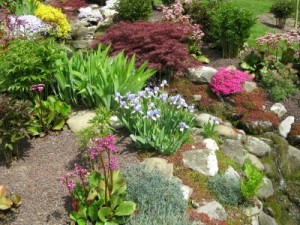 When rock gardens fail, it's usually due to poor planning. Although it sounds like a contradiction, some basic rules and principles need to be applied when trying to construct and recreate the randomness and beauty of Mother Nature.
When rock gardens fail, it's usually due to poor planning. Although it sounds like a contradiction, some basic rules and principles need to be applied when trying to construct and recreate the randomness and beauty of Mother Nature.
Gardeners with limited space can use containers, pots, or troughs to house rocks plants. Artificial stone mixtures come in a variety of colors and can be applied to the outside of containers to create a more natural look.
For alpine plants, this is followed by a fairly long winter spent under a layer of thick, insulating snow. Rarely do these plants encounter the prolonged growing seasons, extreme heat, and high humidity that they have to endure while growing in our backyards. This can make selecting the plants a bit tricky.
Prostrate: These are the cascading plants that spill over and sprawl in between rocks.
Large Specimens: Used in open spaces or planted at angles in between rocks.
Rosette forming Plants: Often tucked into crevices. An example would be hen and chicks.
Most rock garden plants are perennials. Because many rock garden plants tend to bloom in early spring, some gardeners also mix in heat-loving annuals and bulbs for year round color.
Good places to start looking for plants are local nurseries - especially those specializing in native plants. Rock gardening has become increasingly popular and many nurseries and garden centers are responding by offering a variety of interesting plants.
Getting plants from reputable local nurseries means they'll be well suited to your growing zone and they will probably also be much larger than those acquired from a catalog. To round out your collection, look for plants that form compact mounds, carpets or mats, and plants that spread by runners.
Once plants get established, they are likely to need less frequent watering than other plants in your garden. Even so, get to know your plants and what their different moisture requirements are.
Too much moisture may cause root rot in some plants, while too little water may cause severe stress to others. In general, deep, infrequent watering is better than frequent light watering.
Mulching with a layer of small pebbles will conserve moisture, discourage slugs, and blend in nicely with the surrounding landscape. If you're growing plants with a lot of different moisture needs, it may be better to spot water individual plants.
Place larger stones at the base and smaller stones toward the top. Avoid creating patterns. Instead, strive for randomness. You will achieve a more natural look by grouping rocks in uneven clusters along with leaving a few spaces open for plants and randomly placed stones.
Rocks will look more natural if at least 1/3 of the rock's height is partially buried in the soil. Place the broadest side down in the soil and slant all of the rocks at a similar angle so that the tips point slightly up to direct water back toward the plants. This will help conserve water and help prevent erosion.
This page contains the following solutions.
Last spring my husband and I decided our front yard needed some landscaping. Instead of hiring a professional we decided to give it a go and we built our own rockery.
Here are the questions asked by community members. Read on to see the answers provided by the ThriftyFun community.
What other plants can I plant with hen and chicks? I am trying to make a rock garden.
Sedum ground cover. www.outsidepride.com/
Check out these photos.
I think this is probably one of my best masterpieces in my gardens. I use waterfalls or ponds and turn them into plants and flower beds.
The other day we had to do some digging, to install a rock wall that was to be the border for our flower garden, and Ashlyn wanted to help us dig, so I gave her my shovel, and she helped Granddad dig the border for the retaining wall.